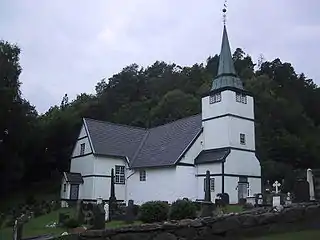Dypvåg
Dypvåg is a former municipality in the old Aust-Agder county, Norway. The 15-square-kilometre (5.8 sq mi) municipality existed from 1838 until its dissolution in 1960 when it was merged into the present-day municipality of Tvedestrand which is in Agder county. The small municipality included the coastal area about 8 kilometres (5.0 mi) east of the town of Tvedestrand and several islands located just offshore. The administrative centre was the village of Dypvåg where the Dypvåg Church is located.[1]
Dypvåg herred
Dybvaag herred (historic) | |
|---|---|
 View of the local church | |
 Aust-Agder within Norway | |
 Dypvåg within Aust-Agder | |
| Coordinates: 58°37′34″N 09°03′08″E | |
| Country | Norway |
| County | Aust-Agder |
| District | Østre Agder |
| Established | 1 Jan 1838 |
| Disestablished | 1 Jan 1960 |
| Administrative centre | Dypvåg |
| Area | |
| • Total | 15 km2 (6 sq mi) |
| *Area at municipal dissolution. | |
| Population (1960) | |
| • Total | 1,805 |
| • Density | 120/km2 (310/sq mi) |
| Time zone | UTC+01:00 (CET) |
| • Summer (DST) | UTC+02:00 (CEST) |
| ISO 3166 code | NO-0915 |
| Created as | Formannskapsdistrikt in 1838 |
| Succeeded by | Tvedestrand in 1960 |
History
The parish of Dybvaag (later spelled "Dypvåg") was established as a civil municipality on 1 January 1838 (see formannskapsdistrikt law). On 1 January 1881, a part of the municipality of Holt (population: 52) was transferred to Dypvåg. Then later, on 1 January 1887, an uninhabited part of neighboring Søndeled municipality was transferred to Dypvåg. On 1 January 1902, the western half of Dypvåg (population: 1,892) was separated from the rest of Dypvåg (population: 3,235) to form the new municipality of Flosta.
During the 1960s, there were many municipal mergers across Norway due to the work of the Schei Committee. On 1 January 1960, the municipality of Dypvåg (population: 1,805) was merged with the neighboring municipality of Holt and the town of Tvedestrand to form a new, enlarged municipality of Tvedestrand which had a population of 6,432.[2]
Name
The municipality (originally the parish) is named after the old Dybvaag farm (Old Norse: Djúpvágr or Djúpivágr) in what is now the village of Dypvåg, since the first Dypvåg Church was built there. The first element comes from dype which means "deep" and the last element is våg which means "water" or "harbor". The spelling of the name was changed from Dybvaag to Dypvåg around the beginning of the 20th century.[3]
Government
All municipalities in Norway, including Dypvåg, are responsible for primary education (through 10th grade), outpatient health services, senior citizen services, unemployment and other social services, zoning, economic development, and municipal roads. The municipality was governed by a municipal council of elected representatives, which in turn elected a mayor.[4]
Municipal council
The municipal council (Herredsstyre) of Dypvåg was made up of 21 representatives that were elected to four year terms. The party breakdown of the final municipal council was as follows:
| Party Name (in Norwegian) | Number of representatives | |
|---|---|---|
| Labour Party (Arbeiderpartiet) | 6 | |
| Conservative Party (Høyre) | 7 | |
| Liberal Party (Venstre) | 8 | |
| Total number of members: | 21 | |
| Party Name (in Norwegian) | Number of representatives | |
|---|---|---|
| Labour Party (Arbeiderpartiet) | 5 | |
| Conservative Party (Høyre) | 6 | |
| Liberal Party (Venstre) | 9 | |
| Total number of members: | 20 | |
| Party Name (in Norwegian) | Number of representatives | |
|---|---|---|
| Labour Party (Arbeiderpartiet) | 5 | |
| Conservative Party (Høyre) | 7 | |
| Joint list of the Liberal Party (Venstre) and the Radical People's Party (Radikale Folkepartiet) | 8 | |
| Total number of members: | 20 | |
| Party Name (in Norwegian) | Number of representatives | |
|---|---|---|
| Labour Party (Arbeiderpartiet) | 6 | |
| Conservative Party (Høyre) | 7 | |
| Joint list of the Liberal Party (Venstre) and the Radical People's Party (Radikale Folkepartiet) | 7 | |
| Total number of members: | 20 | |
| Party Name (in Norwegian) | Number of representatives | |
|---|---|---|
| Labour Party (Arbeiderpartiet) | 2 | |
| Conservative Party (Høyre) | 9 | |
| Joint List(s) of Non-Socialist Parties (Borgerlige Felleslister) | 2 | |
| Local List(s) (Lokale lister) | 8 | |
| Total number of members: | 20 | |
Notable residents
- Jens Marcussen (1926-2007), a politician
- Kristian Vilhelm Koren Schjelderup, Jr. (1894-1980), a theologian
- Peter Olrog Schjøtt (1833-1926), a philologist
References
- Thorsnæs, Geir, ed. (24 July 2015). "Dypvåg – tidligere kommune". Store norske leksikon (in Norwegian). Kunnskapsforlaget. Retrieved 1 January 2018.
- Jukvam, Dag (1999). "Historisk oversikt over endringer i kommune- og fylkesinndelingen" (PDF) (in Norwegian). Statistisk sentralbyrå.
- Rygh, Oluf (1905). Norske gaardnavne: Nedenes amt (in Norwegian) (8 ed.). Kristiania, Norge: W. C. Fabritius & sønners bogtrikkeri. p. 36.
- Hansen, Tore, ed. (12 May 2016). "kommunestyre". Store norske leksikon (in Norwegian). Kunnskapsforlaget. Retrieved 20 December 2020.
- "Kommunevalgene og Ordførervalgene 1955" (PDF) (in Norwegian). Oslo: Statistisk sentralbyrå. 1957. Retrieved 20 December 2020.
- "Kommunevalgene og Ordførervalgene 1951" (PDF) (in Norwegian). Oslo: Statistisk sentralbyrå. 1952. Retrieved 20 December 2020.
- "Kommunevalgene og Ordførervalgene 1947" (PDF) (in Norwegian). Oslo: Statistisk sentralbyrå. 1948. Retrieved 20 December 2020.
- "Kommunevalgene og Ordførervalgene 1945" (PDF) (in Norwegian). Oslo: Statistisk sentralbyrå. 1947. Retrieved 20 December 2020.
- "Kommunevalgene og Ordførervalgene 1937" (PDF) (in Norwegian). Oslo: Statistisk sentralbyrå. 1938. Retrieved 20 December 2020.

